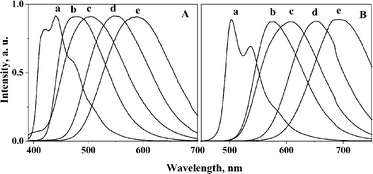Two novel donor–acceptor-substituted vinyltetrahydropyrene derivatives, 2-N,N-dimethylamino-7-(1-carbethoxyvinyl)-4,5,9,10-tetrahydropyrene, 1, and 2-N,N-dimethylamino-7-(1,1-dicyanovinyl)-4,5,9,10-tetrahydropyrene, 2, were synthesized and their photophysical properties investigated in solvents of different polarities. Our studies revealed the existence of intramolecular charge transfer excited states in these molecules. For both compounds the fluorescence maxima exhibited solvent polarity-dependent red shifts. These were quantitatively analysed by the Lippert–Mataga and Liptay equations to obtain the excited state dipole moments. Our results indicated that in the case of 1, emission takes place from a planar 1CT state in all non-protic solvents. In the case of 2, the nature of the excited state depends on the solvent. A fast relaxation to a triplet state is proposed in cyclohexane. The emitting state in medium polar solvents is a planar 1CT state. In highly polar solvents a twisted 1CT state is invoked to explain the low fluorescence quantum yield. For both compounds CT nature of the emitting states were further confirmed by studies in acidic medium. The ground and excited state pKa values for 1 and 2 were determined using absorption and emission spectral changes observed in the presence of protic acids.


 Please wait while we load your content...
Please wait while we load your content...